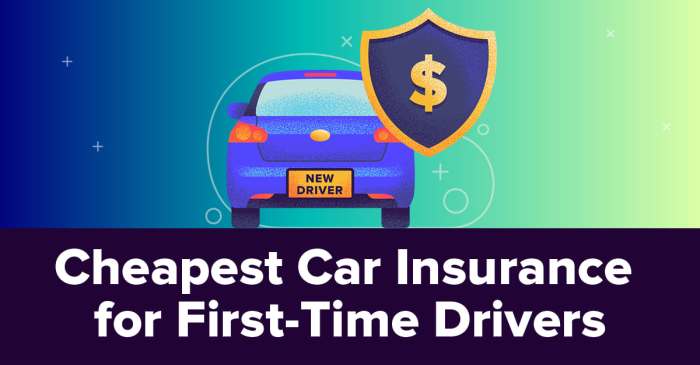Embarking on the exciting journey of driving often feels exhilarating, but the reality of securing car insurance for first-time drivers can seem daunting. High premiums, complex policies, and a lack of driving history can make finding the right coverage feel overwhelming. This guide demystifies the process, offering practical advice and insights to help new drivers navigate this crucial step towards independent mobility.
From understanding the factors that influence insurance costs to exploring available discounts and safe driving practices, we’ll equip you with the knowledge to make informed decisions and secure affordable car insurance. We’ll delve into the specifics of different policy types, comparison tools, and the crucial role parents can play in this process, ensuring a smoother transition into the world of responsible driving.
Understanding the Costs of Car Insurance for New Drivers

Getting your first car is exciting, but the cost of insurance can be a surprise. Understanding the factors that influence your premiums is crucial for budgeting and finding the best coverage. This section will break down the key elements that determine how much you’ll pay for car insurance as a new driver.
Factors Influencing Insurance Premiums for First-Time Drivers
Several factors significantly impact the cost of car insurance for new drivers. These factors are often interconnected, meaning a change in one can affect others. For example, a young driver with a powerful sports car will generally pay more than an older driver with a smaller, more fuel-efficient vehicle.
Age is a primary factor. Younger drivers, statistically, are involved in more accidents. Your driving experience, or lack thereof, is a major consideration. The type of car you drive also plays a role; sports cars and luxury vehicles are more expensive to insure due to higher repair costs and a greater risk of theft. Your location matters as well; areas with higher accident rates or crime will generally have higher insurance premiums. Finally, the level of coverage you choose directly affects your premium; comprehensive coverage is more expensive than liability-only coverage.
Comparison of Insurance Costs Across Different Age Groups of New Drivers
Insurance companies use statistical data to assess risk. Generally, the youngest new drivers (16-18) pay the highest premiums due to their inexperience and higher accident rates. As drivers gain experience and reach their mid-twenties, premiums typically decrease significantly. This reflects the reduced risk associated with increased driving experience and improved driving skills. While precise figures vary by insurer and location, a significant difference in premiums is expected between a 16-year-old and a 25-year-old new driver, with the older driver paying considerably less. This is based on actuarial data demonstrating a lower accident frequency for older, more experienced drivers.
Impact of Driving Record (Even Without a History) on Insurance Rates
Even without a formal driving history, your insurance rates are still influenced by your perceived risk. Insurers consider factors like driver’s education completion, and even your academic performance (some insurers offer discounts for good grades). A clean driving record, even before you’ve had a license, can be beneficial in securing lower premiums later. Conversely, any pre-licensing infractions (like traffic violations) could negatively impact your initial rates.
Sample Insurance Premiums Based on Different Car Types and Coverage Levels
The following table provides estimated premiums. Remember that these are illustrative examples and actual premiums will vary based on individual circumstances and location.
| Car Type | Coverage Level | Estimated Premium (Annual) | Factors Influencing Premium |
|---|---|---|---|
| Economy Sedan (e.g., Honda Civic) | Liability Only | $1200 | Lower repair costs, less theft risk |
| Mid-size SUV (e.g., Toyota RAV4) | Liability + Collision | $1800 | Higher repair costs than sedan, moderate theft risk |
| Sports Car (e.g., Subaru WRX) | Comprehensive | $3000 | High repair costs, high theft risk, higher perceived risk for young drivers |
| Luxury Sedan (e.g., BMW 3 Series) | Comprehensive | $3500 | Very high repair costs, high theft risk, high perceived risk for young drivers |
Finding the Right Car Insurance Policy

Choosing the right car insurance policy as a new driver is crucial, as it protects you financially in the event of an accident and ensures you comply with legal requirements. Finding the right balance between coverage and affordability requires careful consideration of your needs and risk profile. This section will guide you through the process of selecting appropriate coverage levels and understanding the nuances of different policy types and providers.
Appropriate Coverage Levels for New Drivers
New drivers generally face higher insurance premiums due to their lack of driving experience. Therefore, understanding the different coverage levels and choosing the right balance is paramount. While it’s tempting to opt for the cheapest option, inadequate coverage could leave you financially vulnerable in case of an accident. A minimum liability coverage, mandated by law in most jurisdictions, protects others involved in an accident caused by you. However, adding collision and comprehensive coverage can provide more comprehensive protection for your vehicle. The decision often involves weighing the cost of premiums against the potential cost of repairs or replacement in the event of an accident or damage. For example, a new driver with a relatively inexpensive car might opt for higher liability coverage and lower collision/comprehensive coverage, while a driver with a new, expensive vehicle might prioritize higher collision and comprehensive coverage.
Liability, Collision, and Comprehensive Coverage
Liability insurance covers bodily injury and property damage to others if you cause an accident. Collision coverage pays for repairs to your vehicle regardless of fault, while comprehensive coverage protects against damage from events other than collisions, such as theft, vandalism, or weather-related incidents. Liability insurance is usually mandatory, whereas collision and comprehensive are optional but highly recommended, especially for new drivers who may be more prone to accidents. The benefits of collision and comprehensive coverage are clear: they protect your financial investment in your vehicle. However, the drawback is the increased premium cost. Weighing the potential cost of repairs or replacement against the added premium cost helps determine the optimal coverage level. For instance, if you have an older vehicle with a low market value, the cost of comprehensive coverage might outweigh the benefits.
Comparing Insurance Providers and Their Offerings
Different insurance providers offer varying rates and coverage options for young drivers. Some insurers specialize in insuring high-risk drivers, potentially offering higher premiums but greater flexibility. Others might focus on safer driving habits and reward good driving records with lower premiums. It’s essential to compare quotes from multiple providers to find the best deal. Consider factors like discounts for good grades, safe driving courses, and bundled insurance policies (home and auto). Online comparison tools can streamline this process, allowing you to input your details and receive multiple quotes simultaneously. However, always review the policy details directly with each provider before making a decision. For example, one provider might offer a lower initial premium but have stricter terms and conditions, potentially resulting in higher costs down the line.
Understanding Policy Terms and Conditions
Thoroughly reading and understanding your policy’s terms and conditions is crucial. This includes details about coverage limits, deductibles, exclusions, and cancellation policies. Pay close attention to the definition of covered events and any circumstances that might void your coverage. Don’t hesitate to contact the insurer directly to clarify any ambiguities. Ignoring these details could lead to unexpected costs or denied claims in the event of an accident or damage. For example, a policy might exclude coverage for certain types of driving, such as off-road driving or using the vehicle for commercial purposes. Understanding these limitations is crucial to avoid any future disputes.
Parental Influence on Insurance

Obtaining car insurance for a first-time driver can be a complex process, and parental involvement plays a crucial role in navigating this. Parents often act as the primary point of contact with insurance companies, leveraging their established credit history and driving records to secure more favorable rates for their children. Their guidance and support are essential in helping new drivers understand the intricacies of insurance policies and manage the associated costs.
Parents significantly impact the cost of car insurance for their teenage drivers. Their influence extends beyond simply being the policyholder; their actions and involvement directly affect the premiums paid. This influence is multifaceted, impacting factors considered by insurance companies when assessing risk.
Parental Role in Obtaining Car Insurance
Parents typically act as the primary applicant for their children’s car insurance. This is because insurers often require a responsible adult to be associated with the policy, especially for young, inexperienced drivers. Parents provide crucial information, including their driving history, credit score, and address, which can influence the premium calculation. They also handle the administrative tasks associated with the policy, such as paying premiums and managing claims. In essence, the parent acts as a guarantor of sorts, offering stability and mitigating risk for the insurance company.
Strategies for Finding Affordable Insurance
Several strategies can help parents secure more affordable car insurance for their children. Bundling car insurance with other types of insurance, such as homeowners or renters insurance, is a common approach that often leads to discounts. Comparing quotes from multiple insurance providers is essential to identify the most competitive rates. Parents should also encourage their children to maintain good grades, as many insurers offer academic achievement discounts. Choosing a car with lower insurance premiums, such as a smaller, less powerful vehicle, can also significantly reduce costs. Finally, exploring options such as telematics programs, which track driving behavior, can lead to lower premiums if the young driver demonstrates safe driving habits.
Adding Parents to Children’s Policies
Adding a parent to a child’s car insurance policy can, in some cases, lower the overall cost. This is because the insurance company considers the parent’s driving history and credit score, often leading to a better risk assessment and lower premiums. However, this isn’t always the case, and it’s crucial to compare quotes with and without the parent listed on the policy to determine the most cost-effective approach. The specific impact depends on the insurer’s policies and the individual circumstances of the parent and child. For example, a parent with a history of accidents or traffic violations might not lower the premium, and in some cases, could even raise it.
Supporting Children in Maintaining a Good Driving Record
Parents play a vital role in supporting their children’s safe driving habits and maintaining a clean driving record. This involves setting clear expectations, providing regular driving instruction beyond the initial driver’s education, and fostering open communication about safe driving practices. Encouraging responsible driving behavior, such as avoiding distractions like cell phone use, adhering to speed limits, and wearing seatbelts, can significantly reduce the risk of accidents and subsequently lower insurance premiums. Parents can also reinforce the importance of defensive driving techniques and proactive measures to prevent accidents. Regular check-ins on driving habits, and offering support and guidance when needed, are key components of this support system. For instance, a parent could schedule regular check-in rides to observe their child’s driving skills, offering immediate feedback and correction when needed.
End of Discussion
Securing car insurance as a first-time driver doesn’t have to be a stressful ordeal. By understanding the factors influencing premiums, exploring available discounts, and adopting safe driving habits, you can significantly reduce costs and find a policy that suits your needs. Remember, responsible driving and proactive planning are key to managing your insurance costs effectively and enjoying the freedom of the open road with peace of mind. This guide serves as a starting point; always consult with insurance providers directly to personalize your coverage.
Expert Answers
What is the difference between liability and comprehensive car insurance?
Liability insurance covers damages you cause to others’ property or injuries you inflict on others in an accident. Comprehensive coverage protects your own vehicle from damage caused by events like theft, vandalism, or natural disasters.
How long does a traffic violation stay on my insurance record?
The length of time a traffic violation remains on your record varies by state and insurance company, but it typically ranges from three to five years.
Can I use my parent’s driving record to get a better rate?
Some insurers may offer discounts if a parent with a clean driving record is added to the policy, but this isn’t universally applicable. It’s best to check with individual providers.
What if I’m a student with good grades? Does that impact my insurance?
Many insurers offer good student discounts, rewarding academic achievement with lower premiums. Provide proof of good grades (typically a transcript) when applying.